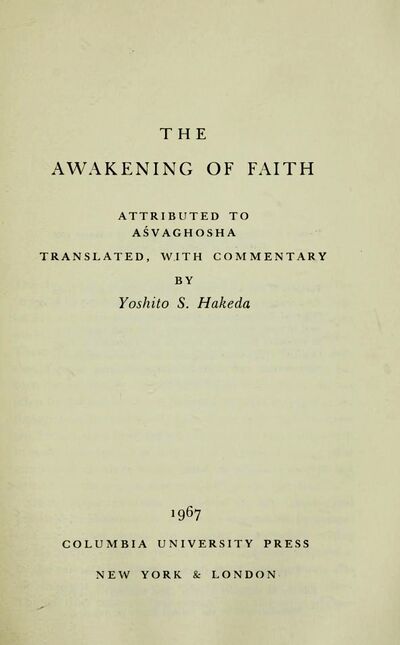|
|
| (2 intermediate revisions by the same user not shown) |
| Line 1: |
Line 1: |
| {{Book | | {{Book |
| |BookPerson={{Book-person
| |
| |PersonPage=Hakeda, Y.
| |
| |PersonName=Yoshito S. Hakeda
| |
| }}{{Book-person
| |
| |PersonPage=Aśvaghoṣa
| |
| |PersonName=Aśvaghoṣa
| |
| }}
| |
| |FullTextRead=No | | |FullTextRead=No |
| |BookToc=**{{i|Foreword, by ''Wm. Theodore de Bary''|v}} | | |BookToc=**{{i|Foreword, by ''Wm. Theodore de Bary''|v}} |
| Line 44: |
Line 37: |
| ******{{i|a. Permeation of Ignorance|56}} | | ******{{i|a. Permeation of Ignorance|56}} |
| ******{{i|b. Permeation of Suchness|58}} | | ******{{i|b. Permeation of Suchness|58}} |
| *******{{i|(1) Permeation Through Manifestation of the Essence | | *******{{i|(1) Permeation Through Manifestation of the Essence of Suchness|59}} |
| of Suchness|59}} | |
| *******{{i|(2) Permeation Through Influences|61}} | | *******{{i|(2) Permeation Through Influences|61}} |
| ********{{i|(a) The Specific Coordinating Causes|61}} | | ********{{i|(a) The Specific Coordinating Causes|61}} |
| ********{{i|(b) The General Coordinating Causes|63}} | | ********{{i|(b) The General Coordinating Causes|63}} |
| | ***{{i|II. The Essence Itself and the Attributes of Suchness, or The Meanings of Mahā|64}} |
| | ****{{i|A. The Greatness of the Essence of Suchness|64}} |
| | ****{{i|B. The Greatness of the Attributes of Suchness|65}} |
| | ****{{i|C. The Greatness of the Influences of Suchness|67}} |
| | ***{{i|III. From Samsara to Nirvana|72}} |
|
| |
|
| II. The Essence Itself and the Attributes of Suchness, or
| | **{{i|Chapter Two: The Correction of Evil Attachments|73}} |
| The Meanings of Mah1 66
| | ***{{i|I. The Biased Views Held by Ordinary Men|74}} |
| A. The Greatness of the Essence of Suchness 66
| | ***{{i|II. The Biased Views Held by the Hinayanists|78}} |
| B. The Greatness of the Attributes of Suchness 66
| |
| C. The Greatness of the Influences of Suchness 68
| |
| III. From SaÅs1ra to Nirv1âa 72
| |
| Chapter Two: The Correction of Evil Attachments 73 | |
| I. The Biased Views Held by Ordinary Men 74 | |
| II. The Biased Views Held by the HEn1yanists 77 | |
| vi contents
| |
| Chapter Three: Analysis of the Types of Aspiration for
| |
| Enlightenment, or The Meanings of Y1na 79
| |
| I. The Aspiration for Enlightenment Through the Perfection
| |
| of Faith 79
| |
| II. The Aspiration for Enlightenment Through
| |
| Understanding and Deeds 83
| |
| III. The Aspiration for Enlightenment Through
| |
| Insight 84
| |
|
| |
|
| Part 4 On Faith and Practice 88 | | **{{i|Chapter Three: Analysis of the Types of Aspiration for Enlightenment, or The Meanings of Yāna|80}} |
| On Four Faiths 88 | | ***{{i|I. The Aspiration for Enlightenment Through the Perfection of Faith|80}} |
| On Five Practices 89 | | ***{{i|II. The Aspiration for Enlightenment Through Understanding and Deeds|86}} |
| The Practice of Cessation 91 | | ***{{i|III. The Aspiration for Enlightenment Through Insight|87}} |
| The Practice of Clear Observation 94 | | |
| Part 5 Encouragement of Practice and the Benefits Thereof 96 | | *{{i|Part 4 On Faith and Practice|92}} |
| Notes 99 | | **{{i|On Four Faiths|92}} |
| Chinese Character Glossary 105
| | **{{i|On Five Practices|93}} |
| Selected Bibliography 107 | | **{{i|The Practice of Cessation|96}} |
| Index 111 | | **{{i|The Practice of Clear Observation|100}} |
| | |
| | *{{i|Part 5 Encouragement of Practice and the Benefits Thereof|103}} |
| | |
| | **{{i|Notes|105}} |
| | |
| | **{{i|A Selected Bibliography|119}} |
| | |
| | **{{i|Index|123}} |
| |AddRelatedTab=No | | |AddRelatedTab=No |
| |StopPersonRedirects=No | | |StopPersonRedirects=No |
| }} | | }} |

